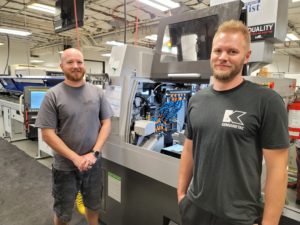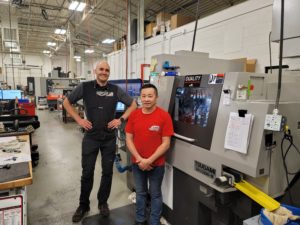Challenge: Looking to consolidate multiple operations around the shop for a family of parts
Machining Solution: SS327-III-5AX, B0386-III
Result: Moved 5 operations to one machine with drastic cycle time reduction
Location: Salt Lake City, Utah
Paramount Machine in Salt Lake City, Utah, is dedicated to thinking outside the box. This mentality stems from management who, despite the rapid growth of the shop, nurtures the small shop feel and shares the success with their crew. It continues through the industries they serve: defense, medical, and other niche categories like snow-making equipment.

Eric Van Orden and Skot Roach in front of the Tsugami SS327-5AX
Eric Van Orden, Screw Machine Lead and Turning Technical Advisor for Paramount Machine, has been with the shop for ten years and acts as a champion of change, especially when it comes to finding creative solutions to improving shop processes.
Van Orden was tasked with upgrading the process for a family of x-ray component parts. “Our original process featured two operations on a chucking lathe, a mill operation, and then it went to the wire EDM operation, and then back to the mill for another operation,” said Van Orden. To cut down on the number of operations, Paramount Machine decided to look at Swiss machines with lathe and mill capabilities. “We wanted to look at a CNC Swiss machine to be capable of manufacturing this part so we could go from the Swiss to the EDM and then ship this part.”
After looking at multiple solutions, Paramount Machine landed on the Tsugami SS327-5AX, a 32 mm, B-Axis Sliding Headstock Swiss-Type Lathe. The B Axis and Y2 capabilities on the SS327-5AX set the machine apart from other machines in its class. “The highest volume part that we were looking to make in this part family has a straight hole drilled through it, but there is a wide variety of parts which feature angled holes,” explains Van Orden. “We knew that utilizing the B Axis on the SS327-5AX would allow us to see the same reduction in cycle among the entire family of parts.”
How much cycle time can you really save by consolidating operations? According to Van Orden, “We were able to replace three separate machine cycles with one Swiss process, and the overall part cycle times were reduced by 92%. Not only was this a dramatic time savings for us, but it also eliminated the need for parts whip throughout the shop.”
Van Orden acknowledges this reduction in time was also due to his partnership with ESPRIT CAM software. He had used their software to program other machines in the shop, so when the new Tsugami hit the floor, he decided to use their SS327-5AX post. “We started with a different swiss machine in our shop that did not come with any software like Tsugami’s Abile. However, the Tsugami/Rem Sales team complimented how well ESPRIT integrates with their machines,” commented Van Orden.
“Our goal is to create a full solution that doesn’t end at making toolpath in the CAM system, rather ends with machine-optimized G-code that will run error-free on your machine,” commented Nick Zentil, Director of North American Sales for ESPRIT. “When you get into a more complex machine tool, like the Tsugami SS327-5AX, you need a post-processor that allows you to access the machine’s full capabilities. We work very closely with the Tsugami/Rem Sales applications team to develop posts for Tsugami machines that do exactly what they are supposed to, make edit free code.”
“I have complete confidence that as long as I set the tools correctly in ESPRIT, I can take that code, post it out and put it in the machine and run it without any issues,” praised Van Orden.

Redd Bradshaw and Cuong Tran in front of the Tsugami B0386-III
This massive time savings, courtesy of the SS327-5AX, acted as a catalyst in changing the way of thinking at Paramount Machine. “Instead of looking at jobs and thinking ‘this is a lathe part’ or ‘this is a mill part,’ we have been experimenting with moving conventional lathe parts to our Tsugami machines,” Van Orden emphasizes. “Tsugami machines can hold better tolerances and finishes better than our traditional processes. We found we can set up and switch between jobs on the Tsugami pretty quickly, especially with the ability to be in Chucker Mode. There is an immediate reduction time due to the nature of the 2-path control.”
“Customer needs are always changing and being able to adapt is essential. For example, we noticed many of our existing customers had increased their lot sizes from 30-40 pieces to a couple hundred. We are also seeing an influx of new customers who are looking for 30-50 pieces, and we actually just purchased a Tsugami B0386-III, a 38mm machine, for these larger diameter, shorter run projects.”
“The Tsugami/Rem Sales staff is exceptional,” said Van Orden. “I can call John Traver anytime, and he is always willing to help. If he can’t answer a question, he knows where to find the answer.”
“I worked on our applications engineering team before moving into sales,” said John Traver, Regional Sales Manager for Tsugami/Rem Sales. “I love working with customers like Eric that allow me to get involved with their projects and allow me to use my engineering background.”
It is not just the sales team that has made an impression on Van Orden. “Recently, we damaged the way cover on our sub side while in the middle of a project that was pretty hot. We called the parts team over at Tsugami/Rem Sales right at closing to see how quickly we could get a replacement part out so we could safely continue running the machine. Not only did they have a replacement in stock, but a member of the team drove the part to UPS on their way home so it would arrive to us the next day. We received the part first thing the following morning, and we were back up and running pretty quickly.”
“The first time I met John, he joked that you can’t just have one Tsugami, they multiply,” joked Van Orden. We have purchased a new Tsugami almost every year since 2015, and Tsugami is constantly in the conversation in the machines we should look at.”
